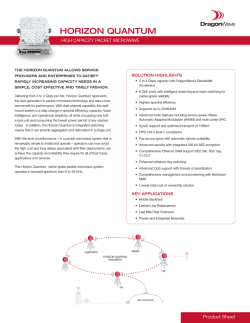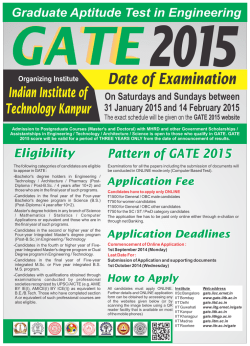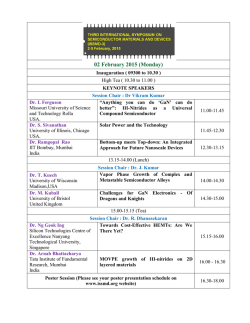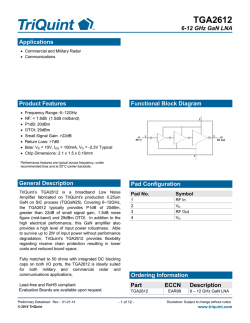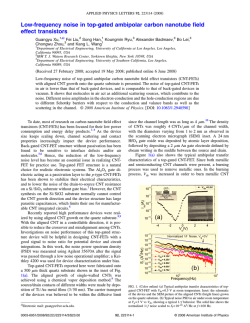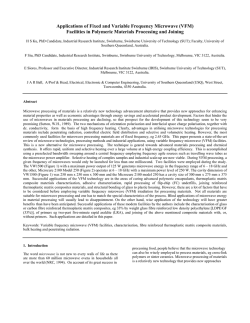
A1GaN/GaN HEMT High-Poeer and Low
UNCLASSIFIED Defense Technical Information Center Compilation Part Notice ADP015121 TITLE: A1GaN/GaN HEMT High-Poeer and Low-Noise Performance at f>20 GHz DISTRIBUTION: Approved for public release, distribution unlimited This paper is part of the following report: TITLE: Proceedings IEEE Lester Eastman Conference on High Performance Devices at University of Delaware, Newark, Delaware, August 6, 7, and 8. 2002 To order the complete compilation report, use: ADA423729 The component part is provided here to allow users access to individually authored sections f proceedings, annals, symposia, etc. However, the component should be considered within [he context of the overall compilation report and not as a stand-alone technical report. The following component part numbers comprise the compilation report: ADP015065 thru ADP015131 UNCLASSIFIED V-2 AlGaN/GaN HEMT high-power and low-noise performance atf > 20 GHz I.P.Smorchkova1 , M.Wojtowicz', R.Tsai1 , R.Sandhu', M.Barsky1 , C.Namba1 , 1 , R.Dia', M.Truong1 , D.Ko1 , J.Wang2 , H.Wang 2, A. Khan 2 P.H.Liu 1TRW, Space andElectronics, One Space Park,Redondo Beach, CA 90278 2Departmentof ElectricalEngineering, University of South Carolina,Columbia, SC 29208 Abstract In this paper, we report on the power and noise performance of A1GaN/GaN HEMTs in the K (18 - 27 GHz) band. At 20 GHz, a record CW output power of 2 W with an associated gain of 8 dB and PAE of 33 % has been achieved on a 8-finger 0.2 pm x 500 gm device. Minimum noise figure of 1.4 dB has been achieved on a 0.15 gm x 200 gm device at 26 GHz. The data demonstrate the viability of AIGaN/GaN HEMTs for high-frequency power and LNA applications. I. Introduction The high breakdown fields, high electron saturation velocity, and high electron densities in AlGaN/GaN HEMT structures have led to microwave power performance significantly exceeding the performance of state-of-the-art GaAs and InP-based devices [1-3]. Demonstrated low minimum noise figures make AlGaN/GaN HEMTs very attractive for use in robust low-noise amplifiers (LNAs). Low-noise, high breakdown GaN HEMTs [4] in amplifier front-ends eliminate the need for diode limiters as protection against RF overstress. This can reduce the overall LNA noise figure by ldB. While the performance of GaN BEMTs in the L-Ku bands has been thoroughly investigated in recent years, very few reports are available on the operation of these devices at frequencies above 18 GHz [2,5]. These frequencies are important for satellite communication and high-performance radar applications. In this paper, we report on the power and noise performance of AlGaN/GaN HEMTs in the K (18 - 27 GHz) band. II. Device Fabrication The A1GaN/GaN structures were grown by metalorganic chemical vapor deposition (MOCVD) on top of semi-insulating 4H-SiC substrates and showed an average sheet resistance in the range of 350-450 £./sq. The device mesa etch was performed using C12/BCl 3 ICP etching technique. Ti/A1/Ni/Au ohmic contacts with an 0-7803-7478/02/$17.00 © 2002 IEEE 422 V-2 average contact resistance of 0.6-0.8 Q mm were formed by alloying at 880 'C in a nitrogen atmosphere. Electron beam lithography was utilized to fabricate 0.12-0.2 ptm Pt/Au T-gates in a 2 plm source-drain region. The source to gate distance was 0.8 Prm. The devices were passivated with PECVD SiN and two levels of interconnect metal including airbridges were used for external connections. The AlGaN/GaN HEMTs had a peak transconductance of - 300 mS/mm and a maximum drain current density in excess of 1 A/mm (measured at VG = + IV). The typical on-state breakdown voltage was 35-40 V. A negative output conductance was observed under high bias conditions for large gate periphery devices due to self-heating effects. Small-signal RF measurements yielded a unity gain cut-off frequency (ft) of 34 GHz for HEMTs with 0.2 gxm gates, 44 GHz for 0.15 gxm devices, and 50 GHz for 0.12 prm HEMTs. The maximum frequency of oscillations (fm) was around 77 GHz for 0.15 and 0.2 gimgate devices and 103 GHz for 0.12 pam HEMTs. M. Microwave Power Performance Continuous wave power measurements at 20 GHz were performed on 8-finger devices with the total gate periphery of 500 pgm and the gate pitch of 40 pm using a Qband Focus load-pull system. The results of the on-wafer load-pull measurements are shown in Fig. 1. ""- 20 GHz, CW 40 -0.5 mm gate periphery LU Sa- 30 as P PAE 33% A3PAE 20 2 10 P9Gin(dm 0 510 15 Pin (dBm) 20 25 Figure 1. Power performance of a 500 gxm AIGaN/GaN HEMT showing a total CW output power of 2 W at 20 GHz. The device was biased at VDS = 25 V and IDs = 250 mA. 423 V-2 When biased and tuned for the maximum output power, the device under investigation showed the total output power of 2 W with an associated power added efficiency (PAE) of 33 % and gain of 8 dB. To the best of our knowledge, this is the highest total output power reported for AIGaN/GaN transistors at 20 GHz. Note, that the device was not driven far into gain compression in this case and the measured maximum output power was limited by the available input drive power. IV. Microwave Noise Performance High frequency noise performance of the devices was measured using an ATN noise parameter test set. Noise figure measurements have been performed from 2 to 26 GHz. A plot of the noise characteristics as a function of frequency for a 0.12 jtm gate device (wafer A) and a 0.15 jim device (wafer B) with the total gate peripheries of 200 jim is shown in Figure 2. The minimum noise figure of 1.4 dB was achieved for the AlGaN/GaN HEMTs at 26 GHz. This is comparable to the NFwin of 1.4-1.6 dB typically demonstrated by GaAs HEMTs at this frequency. 1.8 1 1.6 1.4 - 1 x r Xx x 1 1 1 20 NFmin (sample A) NFmin (sample B) Gain (sample B).'i 18 16 14X 16a x N XXx S1.2 1 E z • 0 .8 XXX N E] 14 112 - Q 10o -8 8Xx 0m• 0.6 04 I 0 5 10 15 20 Frequency (GHz) 6 1 25 30 Figure 2. Minimum noise figure versus frequency for a 0.12 Am A1GaN/GaN HEMT (wafer A, open squares) and a 0.15 jm gate device (wafer B, dark squares) with the gate peripheries of 200 jim. The associated gain is shown for a 0.15 gtm HEMT (crosses). The devices were biased at VDS = 15 V and IDs = 12 mA. An unusual behavior of Fmin is observed for wafer B below 10 GHz where the device noise increases with decreasing frequency. Similar 1/f dependence of NFinj 424 V-2 below - 8 GHZ is often observed in InP/InA1As/InGaAs HEMTs [6]. In InP-based devices, the upturn in the minimum noise figure at high drain-source biases is typically attributed to the increase in the gate current dominated by impact ionization process in the InGaAs channel [6,7]. However, for a typical wide-band gap AIGaN/GaN HEMT one would not expect significant impact ionization to occur at moderate VDS voltages. This is exemplified in our results from wafer A's devices which do not exhibit 1/f dependence of NFmi. (Fig.2) or impact ionization gate current (Fig.3(a)). On the other hand, devices from wafer B do exhibit the bell-shaped feature in IG-VG plots (Fig.3(b)), which is the signature of impact ionization generated gate current [8]. 0.5 Vds =2.5 V 0 -0.5 -1.5 -2 r/Vds -2.5 -6 =20 V step: 2.5V -5 -4 -3 wafer A -2 Vg (V) -1 i 0 1 0 -0.5 .1 -2 step: 2.5 V •---•\ (b -2.5-25wafer B -3 - -6 I I f -5 -4 -3 -2 Vg (V) -1 0 1 Figure 3. Gate current IGversus gate-source voltage VG for (a) a 0.12 gnm x 200 pim AlGaN/GaN HEMT on wafer A, and (b) a 0.15 um x 200 um device on wafer B for different drain-source voltages. 425 V-2 The impact ionization gate current for the devices on wafer B correlates to significant increase in the low-frequency noise. Figure 4 shows that the magnitude of llf dependent NFl-a• increases almost proportionally with impact ionization generated gate current. On the other hand, devices on wafer A do not show any evidence of the impact ionization and, as a result, the low-frequency noise is significantly smaller in this case. More studies are currently under way to determine the reasons for such a significant difference in the device behavior between different AIGaN/GaN wafers. 2 1 I ES EH 1.5 E 00 0E 0 [] 0[ O00•oQ 0 0 1 5 0 om000 0 Id= 12 mA 00 00 0.5 1 1 * Vds=5V, Ig=391 uA o Vds=10V, Ig=621 uA EH Vds=1 5V, Ig=940 uA 1 I 1 20 15 10 Frequency (GHz) I 25 30 Figure 4. Minimum noise figure versus frequency for a 0.15 ptm x 200 gxm A1GaN/GaN HEMT (wafer B) at different values of VDs: 5 V (dark circles), 10 V (open circles) and 15 V (squares with crosses). The drain current was kept constant at 12 mA. V. Summary In summary, we demonstrated an excellent power and microwave performance of AlGaN/GaN HEMTs atf> 20 GHz. The maximum total CW output of 2 W with an associated power added efficiency of 33 % and gain of 8 dB was measured on a 8finger 500 gxm device. Minimum noise figure of 1.4 dB has been achieved on a 0.15 gxm x 200 gxm device at 26 GHz. The presented data demonstrate the viability of AlGaN/GaN HEMTs for high-frequency power and LNA applications. 426 V-2 References [1] L.F. Eastman, Cornell University's 20th Final Quarterly Report under NMUR Contract No. N0014-96-1-1223. [2] M.Micovic, A.Kurdoghlian, P.Janke, P.Hashimoto, D.W.S.Wong, J.S.Moon, L.McCray, and C.Nguyen, IEEE Trans.Electron.Dev. 48, 591 (200 1). [3] J.W.Palmour, S.T.Sheppard, R.P.Smith, S.T.Allen, W.L.Pribble, T.J.Smith, Z.Ring, J.J.Sumakeris, A.W.Saxler, and J.W.Milligan, IEDM 2001. [4] W.Lu, J.Yang, M.A.Khan, and I.Adesida, IEEE Trans.Electron.Dev. 48, 581 (2001). [5] J.S.Moon, M.Mficovic, P.Janke, P.Hashimoto, W.S.Wong, R.D.Widman, L.McCray, A.Kurdoghlian, and C.Nguyen, Electronics Lett. 37, 528 (200 1). [6] M.R.Murti, J.Laskar, S.Nuttinck, S.Yoo, A.Raghavan, J.I.Bergman, J.Bautista, R.Lai, R.Grundbacher, MJBarsky, P.Chin, and P.H.Liu, IEEE Trans.Microwave Theory Tech., 48, 2579 (2000). [7] M.W.Pospieszalski, W.J.Lakatosh, R.Lai, K.L.Tan, D.C.Streit, P.H.Liu, R.M.Dia, J.Velebir, IEEE MTT-S Digest, pp.515-518 (1993). [8] A.A.Moolji, S.R.BahI, and J.A.del Alamo, IEEE Electron Dev.Lett., 15, 313 (1994). 427
© Copyright 2025

